If a vegan has a heart attack, NOW what do they eat?
As a vegan, you don’t consider heart disease as something that will affect you, especially not in your 40s. So I didn’t believe that as a possibility when I felt tightness in my chest, and my arms felt weak.
I thought by being vegan for 15+ years and vegetarian for 22+ years I would avoid the heart disease and type 2 diabetes in my family. Apparently not.
And while I was not a health food super fit vegan, I also wasn’t a junk food slothy vegan slamming Oreo’s and potato chips. I think like many vegans I was somewhere in between. Sure, we occasionally made Daiya Mac & Cheese from the box ate decadent fatty veggie burgers like the Beyond Burger, and ate vegan doughnuts when we found them (thankfully, that’s a rare occurrence.)
On the other side of that, we destroyed tons of kale, I defaulted to whole grains, and almost never chose the deep-fried option. Also, I rarely drink and never smoked. And yet, I still had a heart attack at 49 years old.
Why? I have no fucking clue.
The cardiologist answered that it must have been the family history. And he said that I would probably be on drugs the rest of my life.
Fabulous.
Okay, well, I’m not going to rely on drugs to help me get healthy. Don’t worry; I’m taking them all as directed. But I’m also cleaning up my diet.
Gathering Information
To get my diet in order, I’m reading everything I can find.
In the past, I’ve read The China Study and Eat to Live. I’ve also read some of Dr. McDougall’s books.
More recently I’ve read How Not To Die by Dr. Greger, Prevent and Reverse Heart Disease by Dr. Esselstyn and Plant-Based Nutrition 2E. I just virtually cracked open The End of Heart Disease by Dr. Joel Fuhrman on my Kindle. I’m only partway through, but so far Dr. Fuhrman’s book has had the best explanation of the kind of heart attack I had.
Frustrations
So, here’s the thing. I wasn’t eating the Standard American Diet (SAD). I was eating a moderately healthy vegan diet for over 15 years. And it still happened to me.
Dr. Esselstyn says over and over in Prevent and Reverse Heart Disease that if you have a cholesterol level less than 150, you will not have heart disease.*cough* Mine was 134 when I had my heart attack.
No, I’m not misreading that or exaggerating. Check it out.
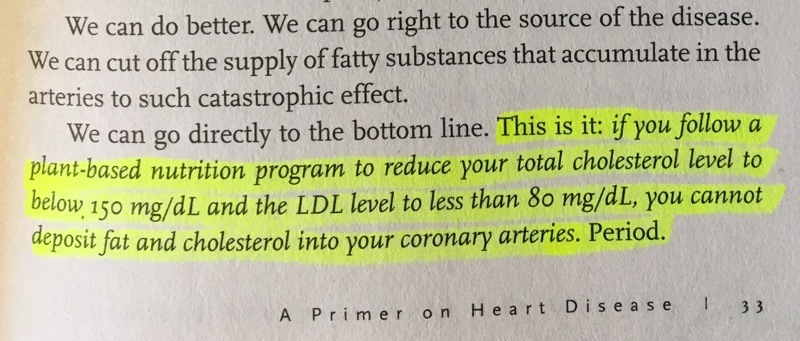
That’s a bold statement. I’d understand something like “in my study” or “for most people” Maybe he’ll temper that statement with some caveats later. Nope, he doubles down.

Triples down.
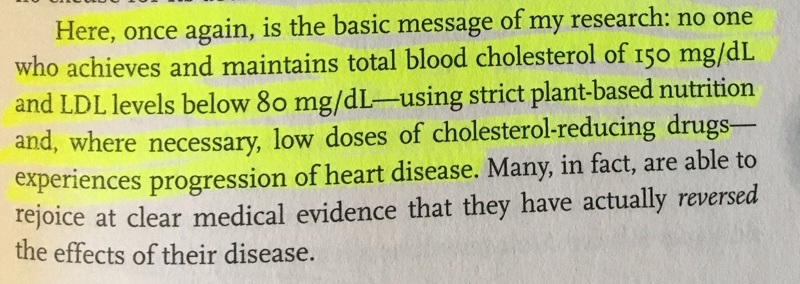
Quadruples down.
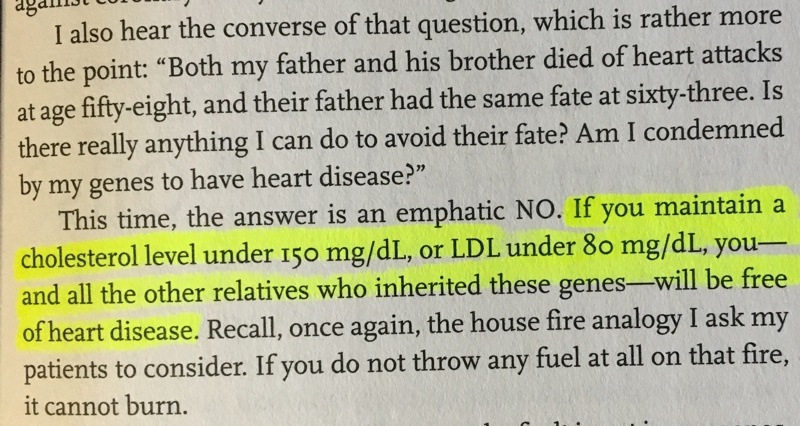
And then he brings in a reinforcement.
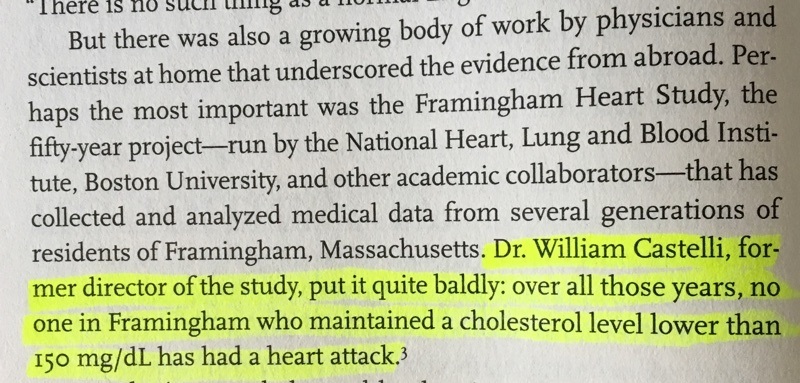
I get it. A bold statement can get people to make bold changes. But it just makes me call into question all other claims he makes. Because I already had a cholesterol level under 150 and an LDL under 80. This example is why it’s important to take in many sources, not only when it comes to your health but in all things.
What I’m Eating Now

I’m not a doctor or a registered dietician. I’m just someone taking in as much information as I can to formulate a plan that’s right for me. Nothing here should constitute medical advice. Everyone has a unique set of circumstances and should work with their doctors and dieticians to make their plan. And arm yourself with knowledge! Read everything you can about your condition and ask questions.
All that said, I based my decisions on a few factors. First, I never had high blood pressure. Second, while my cholesterol was 134 and my LDL was 69, my HDL was 26 (low compared to LDL), and my triglycerides were 196 (high.)
My heart is in great shape except for the part that gave me a heart attack. There I have plaque causing a 30% obstruction. It ruptured throwing out a blood clot which is what prompted my heart attack.
So, my goals are:
- Lower my cholesterol/HDL ratio, which was at 5.2 where under 4.5 is recommended, by raising my HDL levels while holding my LDL steady or lowering it slightly
- Lower my triglycerides
- Dissolve that plaque
- Lose weight
- Exercise regularly
- Reduce doses or come off of as many drugs as possible as soon as possible
A few changes to my diet

I’ve been vegan for 15+ years which means I’ve consumed no dietary cholesterol in all that time. But that doesn’t matter because your body makes cholesterol by design. The American Heart Association has a simple description of the process here.
My low HDL level may have made it hard for my body to dispose of excess cholesterol my body was making. And, consuming saturated fats (coconut oil, palm oil) could have caused my body to produce more cholesterol.
High triglycerides also contribute to the equation.
So, taking into account Dr. Greger’s information about getting the most nutrient dense foods possible and Dr. Esselystyn’s advice for reversing heart disease, here’s what I’m doing:
- No added oils, only whole food fat sources in moderation (nuts, seeds, avocado)
- No refined sugars
- Limited sodium intake (I’m currently averaging about 1200-1500mg/daily)
- Only eat whole grains
- Eat about three servings of fruit daily
- Eat more fiber – this is hard not to do when eating whole food plant based
Examples of meals I’ve been eating
My typical breakfast

I eat oats for breakfast every day either old fashioned or steel cut. I have two different formulas I follow. When we’re on shore power, I make microwaved old fashioned oats. I add 1/2 cup of berries, usually blueberries, a tablespoon of ground flax, a pinch of green tea, two tablespoons of walnuts, and 1/4 teaspoon of turmeric.
When we’re boondocking, overnight oats are easier. I’ve been using this recipe from the How Not to Die cookbook. I also add walnuts, green tea, and turmeric to this.
Protip: you can use steel cut oats to make overnight oats also. Just use a smaller amount. I use 1/3 cup steel cut oats to 3/4 cup liquid.
Oats for breakfast gets the day started with fiber and omega 3s from the nuts and seeds. And blueberries are nutrient-dense anti-oxidant powerhouses.
I also have a cup of coffee, sometimes two, with unsweetened vanilla almond milk.
Lunch and Dinner
I’ve put lunch and dinner together because they’re pretty much interchangeable. We do usually have fruits for lunch as well.
While I avoid most processed foods, I still rely on veggie burgers quite a bit. Thankfully, I’ve now found a recipe that’s healthy and easy to make in the RV. I’m looking forward to playing with this basic formula to create different tasty versions.
Here are a few examples of meals we’ve been eating post-heart-attack. Recipes linked when available.
Beyond Meat’s chicken strips, black beans, salad greens, red cabbage, avocado, tomatoes, carrots and red bell pepper over brown rice with cashew nacho sauce.
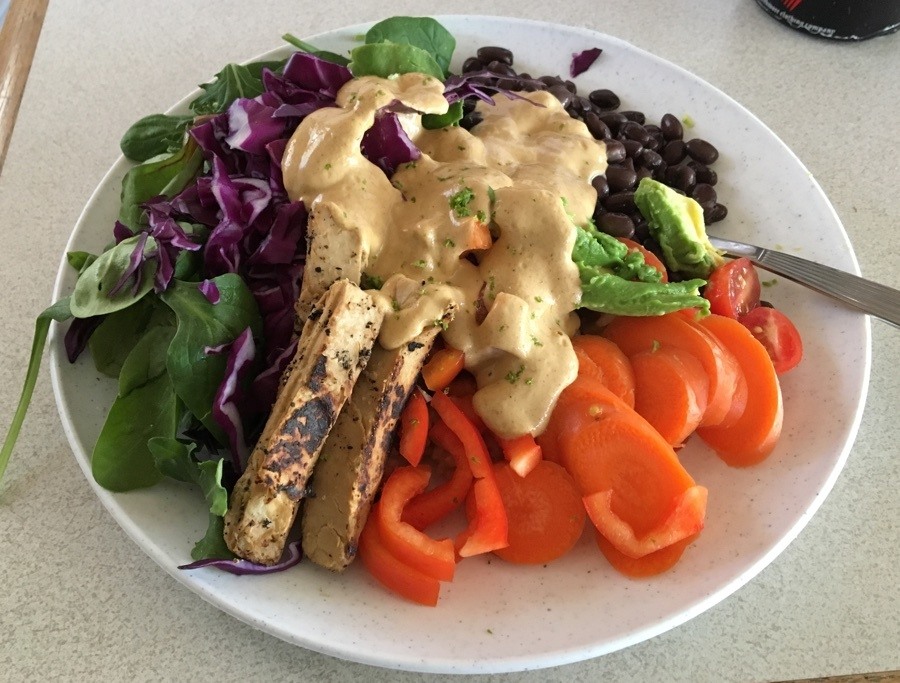
The healthiest commercial veggie burgers I’ve found are the Engine 2 Plant-Strong line. I’ve seen them at Whole Foods.
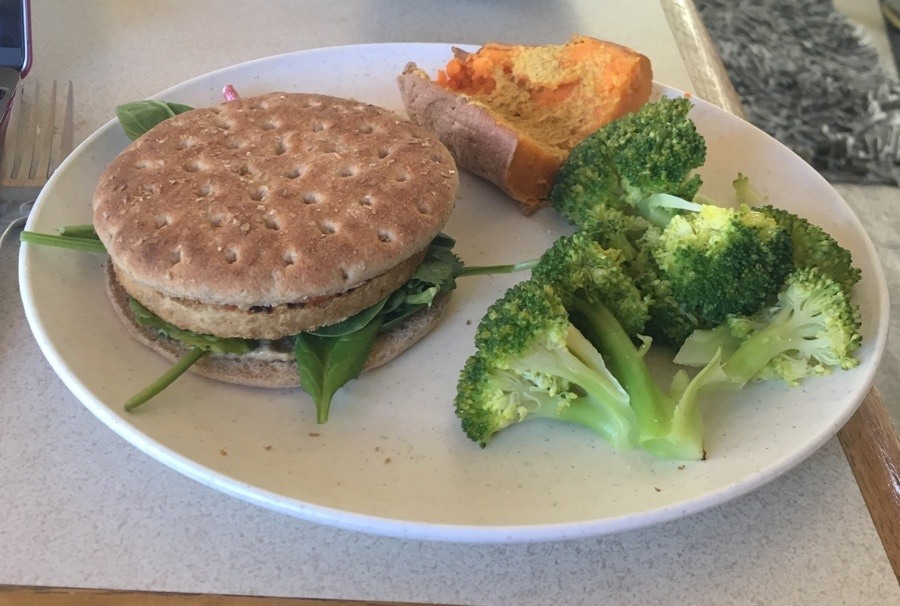
When roasting vegetables, make extra, so plates like this come together easier. Here I have roasted cauliflower and sweet potato, edamame, sauteed kale and Beyond Meat chicken strips over quinoa with a balsamic dressing. 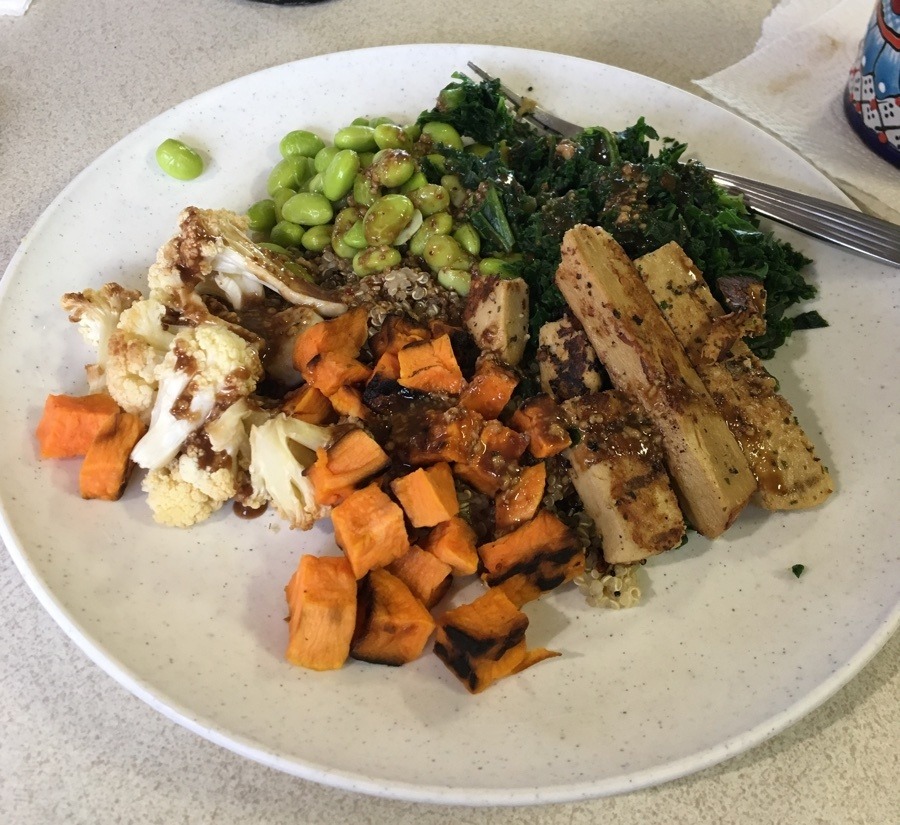
Veggie burger, half a sweet potato with nutritional yeast (do you see a pattern yet?), and Sesame Purple Cabbage & Carrot Slaw from the How Not To Die Cookbook. For some reason, I take pictures of veggie burger plates more than anything else.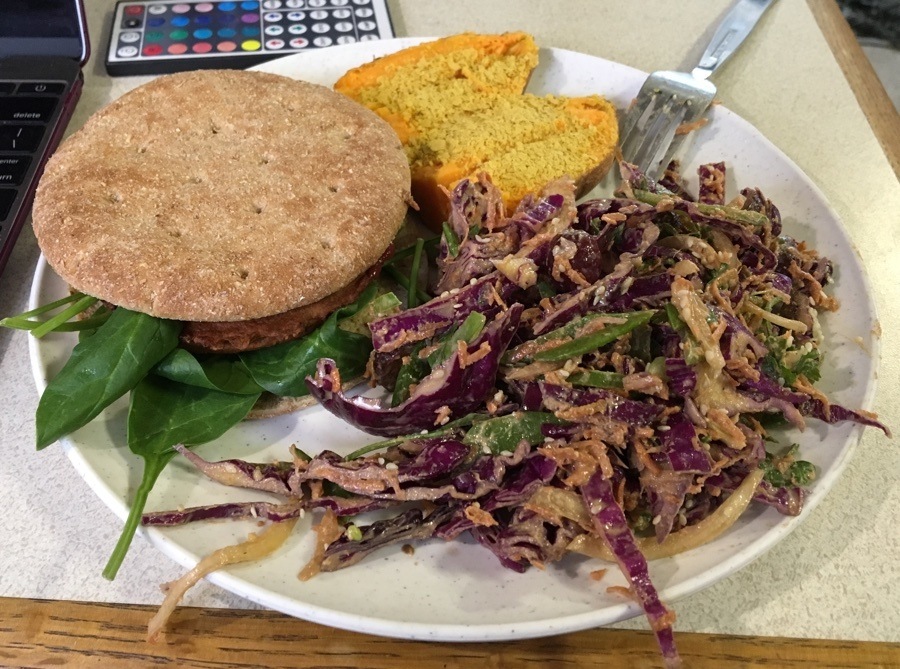
Spicy Asian Vegetable Soup from the How Not To Die Cookbook.
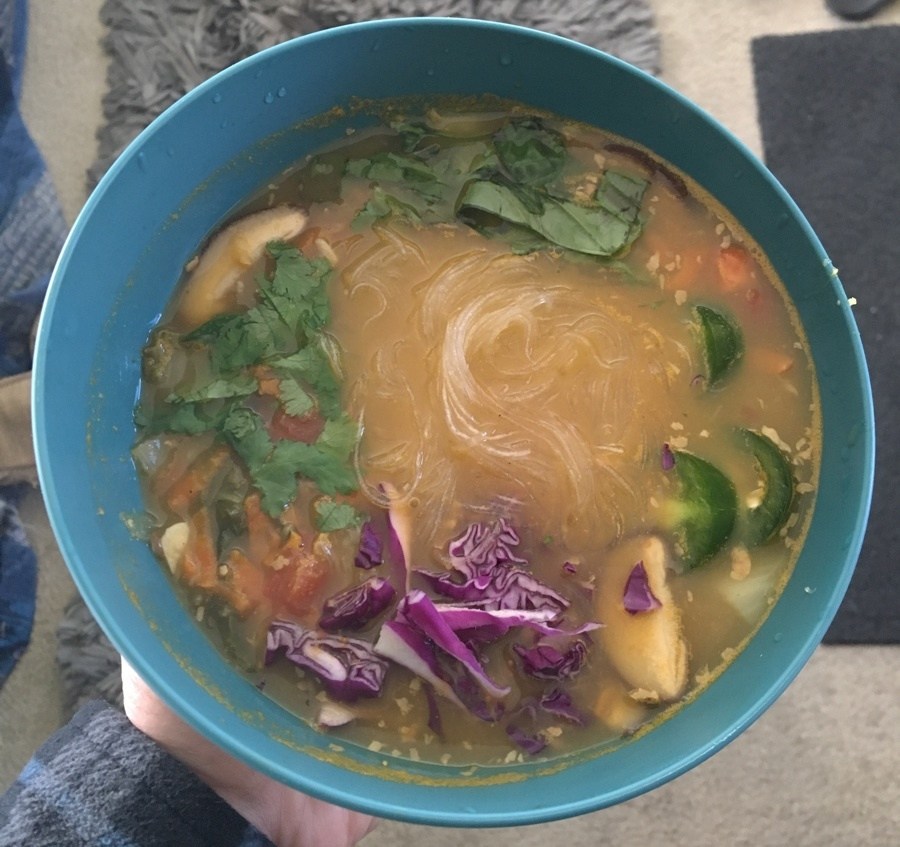
Veggie burger, sauteed kale, and Bean and Artichoke Salad from Prevent and Reverse Heart Disease.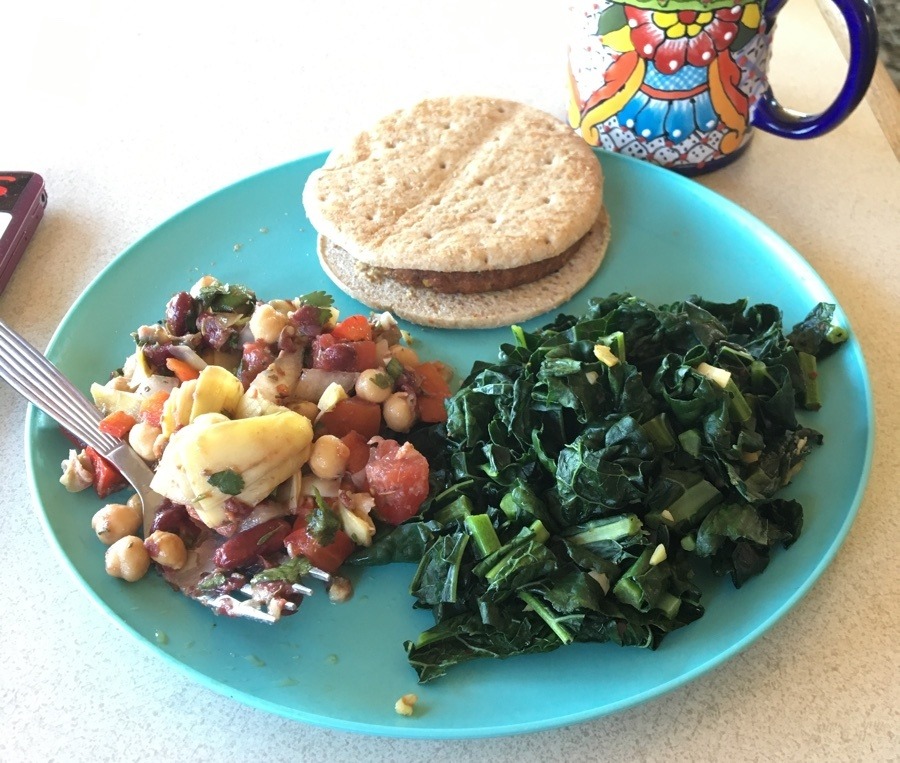
Eating Out
I’ve decided to cover eating out at restaurants in a separate post. Click through to find some examples of what I’ve been eating in restaurants and how I felt about those choices.
Tracking Tools
MyFitnessPal
I track everything I eat in My Fitness Pal. It’s a pain in the butt when you cook mostly from scratch or eat out, but I’ve been keeping up with it since the heart attack. If you’re on My Fitness Pal want to see what I’m up to, you can follow along here.
One thing tracking has taught me is that it’s hard to eat a whole food plant-based diet without higher fat plant foods and meet your calorie goals. Even with the minimal nuts and fats that I eat, I still come well below my recommended calories. I think it’s okay now, but there may be a point where I need somehow to get more calories to maintain weight.
Apple Healthkit
I have an Apple Watch, so this is what I’m using to track steps and exercise. It’s not super accurate, but it’s okay for what I’m doing right now. I also have Polar Watch with a heart rate monitor I can switch to if I ramp up exercise.
Headspace
I started a meditation practice back in December using Headspace. It hasn’t been easy concentrating since the heart attack, but I’m mostly sticking with it.
So, this is what I’ve been doing. I won’t know if I’m on track until I have follow-up bloodwork mid-May. As I read more, I may make more changes along the way. My journey to heart health is an evolving process.
Questions, comments, observations? I’d love to hear from you! Just pop a comment below.
Update: lab test results after 6 months on a whole foods plant-based diet

[…] end this post here. There’s so much more to say. But this is getting long. Next up, is a post about the changes I’ve made to my diet. That’s a long one! And there will be other aspects of this whole thing to talk about like […]
I’m on a similar program (without the heart attack), vegetarian since 15, recently had kids, so I need to live to 65 to see them out of college. So I started watching & reading Dr Gregor & Dr Barnard. I was doing vegetarianism wrong as well, too much cheese, too much white flour, sugar & not enough exercise– all of those implicated in vegetarian causes of heart disease. I follow a much stricter regime now and have excellent numbers according my last doctor tests. I had to look each number up to compare them against the strictest standard. When I was a vegetarian, I was actually a cheesatarian with significant heart disease risk. When I finally became vegan, now my new risk is being a rice-a-tarian and getting too much white starch in my diet. Seems like 1/2 the vegan options at restaurants have white rice by default. Getting simple sugars down to the amount Dr Gregor recommends is hard too because added sugar is in everything- I’d have to start cooking most everything from scratch and give up staples like ketchup.
Here’s the thing – knowing is half the battle. It’s almost impossible to get restaurant food without added salt, sugar, and fat. So I make the best choices I can and try to avoid spots that notoriously deep fry everything. We eat out much less than we used to so I can control these things. Getting dressings and sauces on the side helps.
Prepackaged foods are the worst. I’m the one standing in the aisle reading labels saying “why is there sugar in this?” Or oil. Or massive quantities of salt. Veggie burgers were a staple in the RV and there just aren’t that many out there that I can eat now. The Engine 2 line at Whole Foods is okay. And there are a few others out there that aren’t terrible. But I’ve started making my own too.
Thankfully you’ve started making changes before you had a major health event. And hopefully you won’t ever have one! Even better, if you can steer your kids away from bad habits.
[…] food, but stick to those that are minimally processed with emphasis on occasionally. If curious, this post has more specifics about the changes […]
[…] Many menus are full of deep-fried food, coconut oil, refined flours, refined sugar, etc. – foods I’m trying to avoid. And I don’t want to be that person questioning every single ingredient. So I’d much […]
“When to eat” is more important than “what you eat”…eating during dawn to solar noon window would be good…and just water from solar noon to next dawn…plus an hour everyday of moderate exercise…plus Dr. Joel Fuhrman’s diet…plus mindfulness meditation…these ought to do it
My doctor said no canned foods, including beans and vegetables. Pasta is out. Sodium is out. No fried foods, no substitute foods for dairy or meats. Strictly fruit, vegetables, unsalted nuts, and unsalted grains. Raw or steamed or baked or grilled on an electric grill.
That’s pretty strict but maybe your situation required some drastic measures. Hopefully your situation will improve soon!
Can you go more into detail about what you were eating before the heart attack? I’m not really sure how to gauge my heart attack risk with what I eat. It’s pretty close to how you eat post-heart attack, but not strictly so. Vegan processed ice cream + well rounded whole foods meals,
and eating out at unhealthy places occasionally based on the social need to. Is how you eat now significantly different from how you used to, and if so, in what way? Or is it just minor changes?
Hmm, it’s hard to remember beyond what I’ve posted. I cook a lot from scratch and most of those meals were WFPB except for oil. I used olive oil pretty much exclusively and not a ton of it. We already ate mostly whole grains at home. And like you, we ate out occasionally. Even then I didn’t choose the deep-fried items. My downfall would’ve been dessert.
The changes certainly didn’t seem minor at the time. Removing oil from everything is quite the undertaking! And trying to find commercial non-dairy milks without added sugar or oil isn’t easy either. (Westsoy unsweetened is awesome.)
Right now we’re in Southeast Asia so I’m doing the best I can. I’ll run some blood tests when we get back to see what kind of effect it’s had.
At home, we eat oatmeal for breakfast every morning, made with water, I add in flax, blueberries, turmeric, cinnamon, walnuts, and matcha powder.
We eat a lot of bowls. Whole grain on the bottom, veggies, beans and tempeh or tofu on top. And then I have several oil free sauces I make.
When we eat out, I make the best choices I can but I don’t go so far as to get a plate of steamed veggies. Usually there are a few reasonable things on the menu and if not we don’t go there.
Honestly, no one can tell me WHY I had a heart attack so there’s no way for me to know if any of this is helping. At the time I had the heart attack my cholesterol was 130 which most people would consider excellent. I might have just lost the genetic lottery. Who knows.
Hi Laura,
Had/have you ever had your crp levels checked? Seems there is more and more focus on the inflammation aspects of heart disease.
If you listen to Essylstein he recommends a few pieces of steamed kale with vinegar several times/day to boost the nitric oxide to teflon your artery insides.
My numbers/age sound very similar to yours hold the oils. I also have hdl on the lower side since changing my diet long ago, but women normally have higher hdl from what I understand.
Thanks.
I have. CRP is in the optimal range.
Sugar. Refined MFG fats and oils. Ultra processed foods full of HIGHLY INFLAMMATORY hidden sugars, refined starches (more sugar), and mfg fats and oils. Restaurant food. Farmed fruits is all sugar due to the way they raise it. Best consider it farm candy. Remove all of these for heart health.
Ignore the cholesterol myth. Your body NEEDS cholesterol. Your blood vessels are inflamed by sugar. It oxides your body’s natural cholesterol. Sugar also INFLAMMES the blood vessels and prevents the LDL from moving thru the blood vessel walls. This is ground breaking information from Dr. Ford Brewer MD’s youtube channel. He reversed 20 years of artery plaque thru blood sugar control. Control your blood sugar and get rid of all inflammatory foods from your diet. A clever doctor said: Your mouth will lie but your body doesn’t lie. High triglyceride level is sign of too much carbohydrates i.e. sugar.
If you follow this further down the rabbit hole you’ll find the food “products” we eat today are full of ultra refined ingredients and chemicals which interfere with our body’s cell signaling. The most alarming being disrupting our hormones. For those with weight issues, leptin. (See robert lustig fructose 2.0) For men, low testosterone. (See tracy gapin testosterone epidemic)
My cardiologist and RD agree with my eating plan. And my reading contradicts much of what you say here.
What an unfortunate thing to have happened to you! From a medical perspective it certainly is a very interesting thing, directly contradicting Esselstyn’s findings. Have you tried reaching out to Dr. Esselstyn? He tends to be quite open to discuss critique.
How much time was between the cardiac event and the cholesterol measurement? And do some of the meat replacement products that you are including in your meals contain any processed ingredients such as oil?
No, I haven’t reached out to Dr. Esselstyn. That cholesterol reading was within a day of the cardiac event but it’s in line with every other labwork I’ve had done in the past. Pre cardiac event I used oil when cooking and occasionally ate processed products but I’ve never been one to use a lot of oil. Now I don’t use it at all.
Laura I so appreciate your blog and your adventures and all that you share with us. I too wish I knew what caused your heart attack. I eat a WFPB diet now but for the 1st 20 Yrs of my life my diet was really awful. Better than awful but still quite bad for the next 20. So I worry about the damage I have done. Your story has served to remind me how important it is for me to be strict about a WFPB SOS-FREE diet now. All we can do is try to optimize our situation. Best wishes to you and I would love to meet you if you come back through the Portland OR area.
Thanks for the kind words! We love Portland so we’ll likely be back through there at some point.
This may explain what’s at play: https://nutritionfacts.org/video/treating-high-lpa-a-risk-factor-for-atherosclerosis/
Oh, I had that tested. I’m in the mid-low normal range.